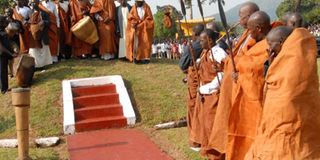Traditions of Bunyoro’s empango

Members of the Abasiita clan stand on a hill in front of the king’s gate to sound the drums that mark the beginning of the Empango. Photo by Francis Mugerwa
The coronation anniversary, traditionally known as Empango, is marked annually on the day the reigning king in Bunyoro ascended the throne.
Rukirabasaija Agutamba Solomon Gafabusa Iguru 1 ascended the Bunyoro-Kitara Kingdom throne on June 11, 1994 after government reinstated cultural institutions that had been abolished in 1967 under the UPC 1 regime.
However, Bunyoro-Kitara Kingdom archives reveal that previously, the Empango celebrations would be marked twice a year.
“The celebrations would be held during every harvesting season,” Yolamu Nsamba, a cultural historian, says.
A harvest time affair
Nsamba, who was the king’s principal private secretary for 19 years, says the king’s subjects would come along with harvests and other forms of gifts which they would offer to honour his good leadership.
The Empango festivals would last nine days but lately, it is celebrated for four days.
Since the reigning king ascended the throne on June 11, his coronation anniversary is held annually on a similar date.
“On this day, the king sounds a big royal drum known as empango which is heard only once a year,” Hajji Bruhan Kyokuhaire, the kingdom’s culture and protocol minister, says.
The drum he sounds is the very drum which he sounded when he ascended the throne, Kyokuhaire adds.
As is the norm in Bunyoro, when the king dies, the drums are turned upside down.
They are also turned upside when a new king ascends the throne.
A series of festivities
Kyokuhaire reveals that Empango is now celebrated for two days in Karukiiza palace, one day at the Queen mother’s residence in Buhanika Sub-county, it is then celebrated for another day at the Omukonda’s residence.
Omukonda is a fortune teller who prophesied that Rukidi Mpuuga I, the first king of the Babiito dynasty would become king of Bunyoro.
Kingdom records show that Mpuuga was the first king from the Ababiito dynasty, who took over the throne from the Bachweezi.
The rituals
Dr Iguru, the reigning Bunyoro king is the 27th in the Babiito dynasty. The performance of rituals on the coronation anniversary begins at 3am.
The king’s sword (kabindango) is put besides a nine-legged throne (nyamyaro) and the king’s walking stick (Omwigo Gwomunembe).
Dressed in back-cloth, the king sits on the Royal throne which is kept at Karuziika palace, the King’s official residence. His wife Omugo Margaret Karunga Adyeeri seats on his right while his mother sits on his left. They are all dressed in back-cloth.
Kyakuhaire says the king blesses the traditional tools going to be drummed by his servants which they then move outside the palace atop a small artificial hill (locally known as Kawa Kali) which is in front of the king’s gate, traditionally known as Mugabante. The king then sends a servant to the head of Abasiita clan George Muhuruzi to direct him to bring the royal drums.
Standing on the hill that is in front of the king’s gate, are members of the Abasiita clan.
The head of the Abasiita drums four times before he is joined by youth blowing traditional trumpets traditionally known as Amakondere and other traditional tools which are sounded as a traditional song known as Irambi is played and sung.
The dancing procession then moves from atop the hill to the palace where the king is seated on the royal throne with beads placed in his hands.
Members of the Abasiita clan bring to the king drums along with cowrie shells, local brew and other historical artefacts.
The head of the Basuuli clan leads a procession from the hill to where the king is. A royal drum Empango Tibamulinde (the biggest drum) is carried ahead of a drum known as Empango Kajumba.
The Omukonda carrying the king’s walking stick is followed by a member from the Abahamba clan holding a garden rake. They are followed by other ritual performers.
“The garden rake, one of the tools used in farming, is symbolic of how agriculture plays a key role in the lives of the Banyoro,” Hajji Ashraf Mugenyi, the kingdom’s deputy minister of culture, says.
One of the king’s servants hands over a drum known as Omunembe which he drums four times.
A ritual performer known as Mpanyarwa, who is also a prince in Bunyoro, brings a bowel where the king touches nine times. Before the king, comes the head of the Abahamba clan holding a small sack of millet that is tied on a garden rake (Orukanduzo).
Spears Kinegena and Kiraazankamba are also brought before the king. The dancers praise the king as they dance towards him.
The royal tools are brought towards the king who permits the dancers to take them back to his courtyard to play for his people. At his discretion, he may also join the dance.
The king then watches his people dance to the music played from traditional musical instruments.
The coronation anniversary festivals begin at 3am. In the morning, guests arrive in the king’s palace. He shows up to the public dressed in royal robes.
Ceremony of nines
A member from the Abasiita clan hands over the big royal drum Empango Tibamulinde to the Omukama which the king sounds nine times. “The figure nine is important in Bunyoro.
Previously, people in Bunyoro would offer gifts in nines,” Mugenyi adds. The king is also given long drums known as Mutengesa, which he drums nine times. A ritual performer known as Mpanyarwa, who is also a prince in Bunyoro, brings a bowel where the king touches nine times.




